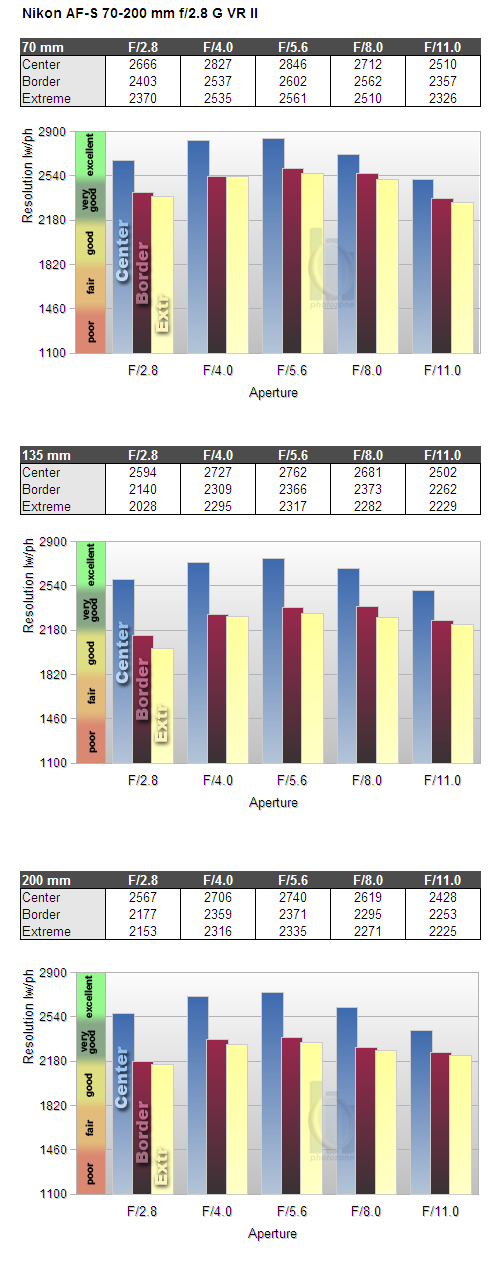|
Page 2 of 2

Distortion
The lens shows only very moderate distortion on a DX camera. There is a tiny amount of barrel type distortion at 70mm and a little pincushion type distortion at 135mm, but both should not be an issue in the field. Pincushion distortion is slightly higher at the long end of the zoom range, but with an amount of below 0.7% still should not be visible with most subjects.
|
Move the mouse cursor over the focal length text marks below to observe the respective distortion
|
| 70mm |
135mm |
200mm |
|

|
The chart above has a real-world size of about 120x80cm.
Vignetting
Being an FX lens, the Nikkor profits from the sweet spot advantage on a DX camera. Consequently, the vignetting figures are very low and nothing to worry about, except maybe at 200mm wide open with really critical subjects.

MTF (resolution)
The lens delivers excellent sharpness in the image center at all focal lengths and all apertures till diffraction kicks in at f/11.
The borders and extreme corners follow a little behind but deliver very good to excellent resolution at 70mm. At 135mm and 200mm the sharpness drops by around one mark of our scale at f/2.8. However, resolution recovers to very good values by stopping down.
Please note that the MTF results are not directly comparable across the different systems!
Below is a simplified summary of the formal findings. The chart shows line widths per picture height (LW/PH) which can be taken as a measure for sharpness.
If you want to know more about the MTF50 figures you may check out the corresponding Imatest Explanations

Chromatic Aberrations (CAs)
Chromatic aberrations (color shadows at harsh contrast transitions) are minor at 70mm but slightly higher at 135mm and 200mm, reaching up to just above 1.6 pixels at the image borders. However, lateral CAs can easily be corrected in software or by the camera itself (most modern Nikon DSLRs remove CAs on-the-fly if you shoot JPGs).

Bokeh
Being a fast tele lens one of the lens' welcome abilities is to separate the main subject from the background so rendering of out of focus areas is an important aspect.The 70-200 VR II delivers a generally very smooth bokeh at all focal lengths with just a minor amount of nervousness in the transition (see the crop of the "king" below).
Thanks to 9 rounded aperture blades background highlights remain circular throughout the whole aperture and focal range. They show a smooth filling with almost no outlining.

Bokeh Fringing
Bokeh fringing is a common issue with relatively fast glass. It's visible as halos of different colors in out-of-focus areas - magenta (red + blue) in front of the focus point
and green beyond.
At it longest focal length of 200 mm (which we used for the shots below) the lens shows a small amount of bokeh fringing wide open, which is considerably reduced by f/4 already.
Sample Images
You can find some sample images taken with the Nikon D3x in our Nikon FX review of the lens.
VerdictThe Nikon AF-S 70-200 VR II is a very good zoom lens that delivers excellent sharpness wide open already, at least in the image center. Vignetting and distortion are no issues on DX cameras. CAs are very low at 70mm and moderate at longer focal lengths. Bokeh fringing is well under control and the bokeh is exceptionally smooth for a zoom lens.
As with almost any lens targeting professional photographers, the build quality is excellent. So, in summary so far, nothing to complain about.
However, there's an issue we haven't talked about in this review, yet: the lens' maximum magnification. The 70-200 VR II increases the field of view with close focus. This is not uncommon, in fact any IF lens does this to a certain degree, but only a few do so at a similar amount. At minimum focus distance (MFD) at 200mm the 70-200 VR II provides an image angle equivalent to a 135mm lens.
This issue has been wildly discussed in the community after it was initially noted. While the lack of magnification is undoubtly a fact, anyone considering purchasing this lens should carefully check if it's really an issue for his/her kind of shooting. When shooting close to the MFD at the long end regularly the previous model is probably the better choice. For anyone usually shooting at longer distances the increase of the image field will be less of an issue since it's not much wider here compared to other lenses in this class.
There may be minor issues but the Nikkor is, nonetheless, highly recommended!
|